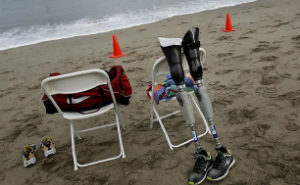Understandably, two of the most common questions from new amputees are, “Can you go swimming with a prosthetic?” and “Can you run with a prosthetic?” We want to assure you that if you are an avid swimmer or you enjoy participating in other athletic sports, an amputation does not have to hold you back.
Fortunately, prosthetics are customized to meet your specific needs and help you reap the benefits of sports and physical exercises. Reliable providers like Horton Orthotics can help you choose the best prosthetic for swimming or running.
In this article, we look at the possibility of swimming and running with prosthetics by answering some common questions relevant to each, including the costs associated with above-knee and running prosthetics.
What is a prosthetic?
A prosthetic is an artificial limb that is fitted onto the residual limb to help an amputee improve their mobility. If you are thinking of getting a prosthetic, there are a few things you need to consider before starting the process.
First, you need to consult with your doctor to assess the mobility of your residual limb. Next, they will advise you on the type of prosthetic most suitable for you based on what led to your amputation. Your expected level and type of activity after the amputation will also count when choosing the right prosthetic. For example, while most prosthetic limbs can withstand rainwater or splash, you will need a waterproof prosthesis if you want to swim with it.
Below-knee prosthetic types are typically easy to use; with their advanced prosthetic technology, they can be used for sporting activities in particular. However, you may be better suited to use an above-knee prosthetic. The cost for these is a bit high, but when done right, they can significantly help you improve your mobility.
Can you go swimming with a prosthetic?
Swimming with your prosthetic is possible. However, your prosthesis has to be fitted properly on your residual limb, and it has to be made from materials that can withstand long periods in water.
Swimming exposes your prosthetic to harsh conditions that can accelerate its wear and tear. Chlorine, salt water, and beach sand may damage your prosthetic if you do not take good care of it. As a swimmer, you should acquire a waterproof prosthesis to enhance corrosion resistance and help protect your residual limb.
If it is your first time swimming with your prosthetic, you should expect a few challenges in balancing. However, your balance and control of your body while in the water become easier as you get used to the prosthetic. In most cases, below-knee prosthetic types are easier to adapt to. Some amputees even find it possible to enter the water without assistance. You may, however, require your instructor to help you adapt to an above-knee prosthetic for swimming.
Can you run with a prosthetic leg?
Much like with swimming, it is entirely possible to run with a prosthetic. What’s more, since running does not expose your prosthesis to the abrasive environment that swimming does, it will make it much easier to protect. You can run and even take part in athletic competitions with your prosthetic. Note, though, that although there are many types of prosthetic, you should look for a lightweight option if you want to participate in athletics.
You can request your prosthetic provider to show you pictures of different kinds of prostheses to choose from. They can also make a recommendation on what type they think is best. In most cases, running prostheses costs are fairly reasonable, but care will be needed to prolong their usage and avoid the need for repeated replacements.
Special considerations for swimming with a prosthesis
Choosing the right prosthetic for you will usually depend on the activities you will be involved in after the limb’s installation. As such, there are certain things to consider with different activities.
As we discussed previously, you will need a waterproof prosthetic for swimming in order to ensure that it can withstand the effects of water. However, this is not the only thing to keep in mind: it is good to also consider the weight of your prosthetic.
Just as with other athletic activities, swimming requires a lightweight prosthetic. If your prosthetic is too heavy, you may not be comfortable or even able to swim or participate in other water sports. If you want to take part in water sports with a prosthesis, you should look for a lightweight prosthetic that is best suited to your particular needs.
Caring for your prosthetic and the skin of the residual limb is also important, as it ensures you do not suffer blisters to the limb or damage to your prosthesis. With swimming in particular, you should clean your residual limb with antibacterial soap and dry it after every session. Additionally, make sure that there are no sand particles in your prosthetic if you were swimming in a beach area.
Horton’s Orthotics can help.
Horton’s Orthotics’ latest technology makes swimming with prosthetics a reality. We offer some of the best prosthetics in the state of Arkansas, and we are a good place to start—even if you just want to learn the types of prosthetics that are available. We even offer pictures with cost estimates (upon request) to help you in making your decision.
If you are ready to get fitted for a swimming prosthesis, or if you have any questions about our services, please contact Horton’s Orthotics and Prosthetics today. It is our mission to help you toward a life of improved mobility.
**SOCIAL SHARE DESCRIPTION: Can you go swimming with a prosthetic? Can you run with a prosthetic? Understandably, these are two of the most common questions from new amputees. Find out how Horton’s latest technology makes swimming and running with prosthetics a reality.


